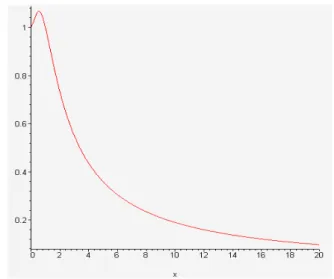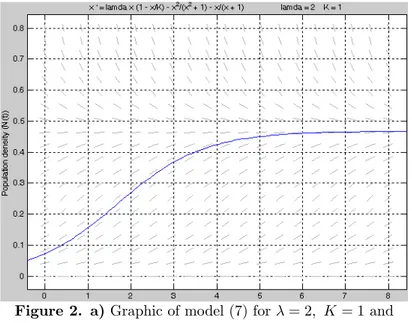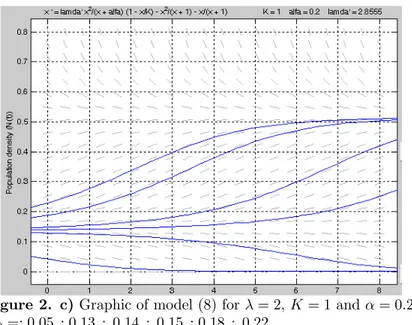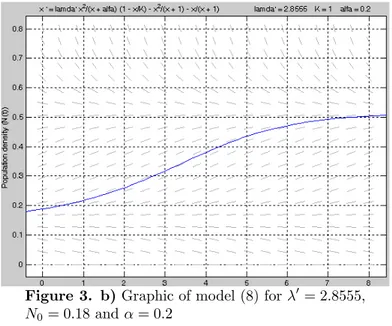Selçuk J. Appl. Math. Selçuk Journal of Special Issue. pp. 55-64, 2010 Applied Mathematics
The Stability of Continuous Population Dynamic Model Depending on the Number of Predators and Allee Effect
Özlem Ak Gümü¸s, Hasan Köse
Selçuk University, Science Faculty, Department of Mathematics, 42003, Kampus, Konya, Türkiye
e-mail: ozlem ak@ selcuk.edu.tr,hkose@ selcuk.edu.tr
Presented in 2National Workshop of Konya Ere˘gli Kemal Akman College, 13-14 May 2010.
Abstract. In this study, the stability of equilibrium point of general continu-ous population dynamic model which include predator number was examined. Besides, the effect of Allee factor on this model was examined as well.
Key words: Population dynamics, Stability analysis, Alleeeffect. 2000 Mathematics Subject Classification: 39A10, 39A30.
1. Introduction
Stability analysis is a very important research subject in many fields which include population dynamics [2-7,9].
Allee effect which was first defined by Allee [1] in 1931, is defined as an effect on per capita growth rate depending on population density. Therefore, Allee effect has different impacts on population models local stability [2-8,9]. Since each population has a different properties, an assessment taking these impacts into consideration will lead us to result closer to reality. This is important as it includes an application of Mathematics to life. In this study, we studied on a population with maximal growth rate at low density.
Merdan and Duman [5], studied stability of the following general continuous-time population model at low population density which include predator effect
(1)
= ( ) − () together with Allee effect.
(2) = ∗ ( ) ( ) − () where ∗= (∗)
per capita growth rate which is always positive. Also, we consider the following biological assumptions on the functions f , g and , respectively,
f1) (0) 0
f2) 0( ) 0 for ∀ ∈ (0 ∞), that is, interactions among the individuals
decreases as density increases.
f3) ( ) has only one positive root.
g1) g(0)=0 and 0 ( ) ∞ for ∀ ∈ (0 ∞),
g2) lim→∞( ) = 0, that is, the predation effect disappears as the
population density gets higher;
g3) g has only one critical point on (0 ∞), that is, there is only one point ∈ (0 ∞)such that 0() = 0, and
(a1) if N=0, then ( ) = 0; that is, there is no reproduction without partners,
(a2) 0( ) 0 for ∈ (0 ∞); that is, Allee effect decreases as density
increases,
(a3) lim→∞( ) = 1; that is, Allee effect vanishes at high densities.
We are going to give some theorems which are valid in our study. Theorem 1. If the following inequality
0(∗) (∗)
0(∗) (∗)
is satisfied at a positive equilibrium point ∗of Eq. (1), the it is locally stable.
[5]
Theorem 2. A positive equilibrium point ∗of Eq. (2) is locally stable if the
following inequality 0(∗) ( ) + 0(∗) (∗) 0(∗) (∗) holds. [5] 2. Essential Findings
(3) () = 1 + 2 for ∀ ∈ (0 ∞), K=1 and () = 1 − (4) = (1 − ) − 2 2+ 1 (5) = ∗ 2 + (1 − ) − 2 2+ 1
Here, for 0 and
∗= (∗) we take () as (6) () = 1 + 2 + 1 + 1
Thus, considering Eq. (1) and Eq. (2) the following equations are obtained, respectively. (7) = (1 − ) − 2 2+ 1− + 1 (8) = ∗∗ 2 + (1 − ) − 2 2+ 1− + 1 Here, () function graphics given with 0 and
∗∗= (∗∗)
Figure 1. a) (3). The general appearance of the function
Figure 2. b)(6) The general appearance of the function
2.1.Population movements for (7) and (8) models according to and invariants
By using Matlab ODE package for = 2 and = 1, for population move-ment we obtain figure 2.a and figure 2.b from Equation (7) and Equation (8), respectively.
Figure 2. a)Graphic of model (7) for = 2 = 1 and 0= 005
Figure 2. b)Graphic of model (8) for = 2 = 1 0= 005
and = 02
When model (8) is reexamined for different beginning conditions, figure 2.c is obtained for population movement.
Figure 2. c)Graphic of model (8) for = 2 = 1 and = 02 0=: 005 : 013 : 014 : 015 : 018 : 022
2.2. Comparison of Models
Figure 3, Figure 4 and Figure 5 give comparison of model (5) and (8) with Allee effect, and without Allee effect and comparison of population behavior of model (5) with Allee effect and without Allee effect.
Figure 3. b)Graphic of model (8) for 0= 28555 0= 018 and = 02
Figure 4. b)Graphic of model (7) for = 2 0= 018
Figure 5. b)Graphic of model (5) for 00= 2526873 0= 005 and = 02
3. Result
Allee effect has both a decisive and indecisive impact on population dynamics. In this study, we observed general first order continuous-time model formed with different predator effect and population movement and stability state with and without Allee effect via a graphic. We also assessed the effect of change in beginning conditions on model behavior and compared the stability of models with graphics. In general situations, we found out that it lasted longer to reach stability in continuous-time models when Allee effect is included into the system. As a result, in the continuous-time model examined in [5], increase in the number of predators caused the time to attain population stability to be delayed more. In this case, at low starting point Allee effect led the population as far as extinction. It is obvious that Allee effect has an important role on stability.
References
1. Allee WC. Animal agretions: a study in general sociology. Chicago: University of Chicago Pres; 1931.
2. Çelik C, Merdan H, Duman O, Akın Ö, “Allee effects on popülation dynamics with delay”. Chaos, Solitons & Fractals 37, 2008, 65-74.
3. Duman O, Merdan H, “Stability analysis of continious population model involving predation and Allee effect”. Chaos, Solitons & Fractals 41, 2008, 1218-1222.
4. Fowler MS. Ruxton GD. “Populations Dynamics consequences of Allee effects”. J. Theor Biol., 215, 2002, 39-46.
5. Merdan H, Duman O, "On the stability analysis of a general discrete-time popüla-tion model involving predapopüla-tion and Allee effects". Chaos, Solitons and Fractals 40, 2009, 1169-1175.
6. Merdan H, Duman O, Akın Ö, Çelik C.“Allee effect on population Dynamics in continous case”. Chaos, Solutions & Fractals 39, 2009, 1194-2001.
7. Murray JD. Mathematical biology. New York: Springer-Verlag;1993.
8. Stephens PA, Sutherland WJ.,“Consequence of the Allee effect for behavior, ecology and conservation”. Trend Ecol Evol., 14, 1999, 401-405.
9. Zhau SR, Liu YF, Wang G. "The stability of predator-prey systems subject to the Allee effects”. Theor Popul Biol., 67, 2005, 23-31.





